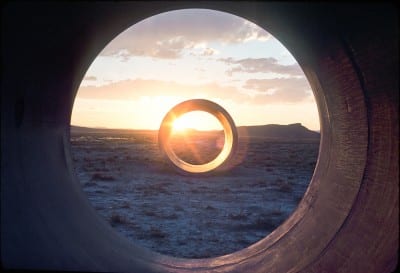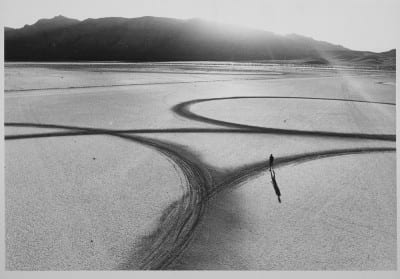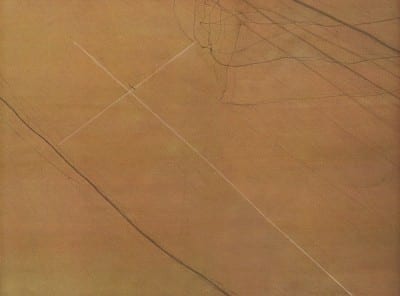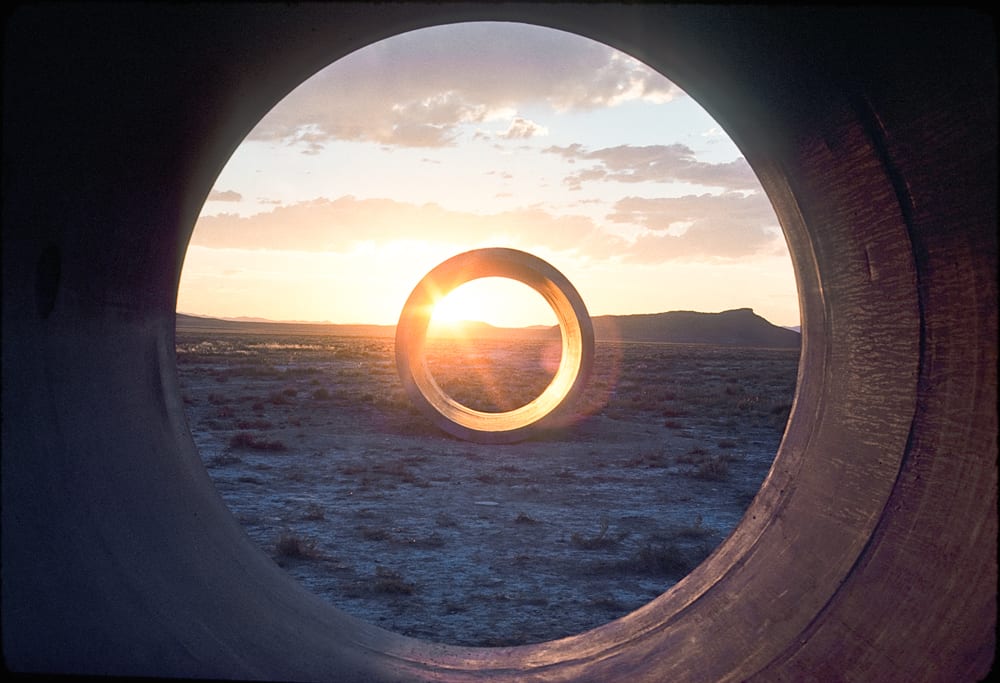From Art Journal 75, no. 2 (Summer 2016)

Troublemakers: The Story of Land Art. James Crump, director and writer, 2015. With Vito Acconci, Carl Andre, Germano Celant, Paula Cooper, Walter De Maria, Virginia Dwan, Gianfranco Gorgoni, Michael Heizer, Nancy Holt, Dennis Oppenheim, Charles Ross, Pamela Sharp, Willoughby Sharp, Robert Smithson, Harald Szeemann, and Lawrence Weiner. New York: Summitridge Pictures and RSJC LLC, 2015. Digital film, b/w and col. footage, 72 min. In release. For information on educational/nontheatrical rentals, purchases, and streaming licenses, see http://firstrunfeatures.com/educationalsales_orderinginfo.html.
An essential moment in the 2015 film Troublemakers: The Story of Land Art occurs ten minutes from the end, when a time-lapse sequence with Virginia Dwan voiceover states that Nancy Holt’s 1976 Sun Tunnels “can only be seen in durational time. It isn’t something you just look at, get, and walk away. When you are out in the middle of the desert, it’s so vast, you can be overwhelmed. But the tunnels will give you a framing device, an orienting device.” It is a rare moment in the film, with a fixed camera recording the shift of light and shadow across a day. Both camera and artwork become legible as frames bridging celestial and individual experience.
Imagine if in addition to capturing shifts in one day—a temporal unit relevant to human perception—Troublemakers had been able to describe this or the other iconic earthworks on a more geologic scale, or at least across the span of their contemporary lives. If we imagine director James Crump constructing something akin to Andy Warhol’s film Empire (1964), a potential emerges of using Land art to see not only through Holt’s tubes but outward beyond their existence as objects. Suddenly it becomes possible to imagine the works as actions, or attitudes, becoming form within a myriad of nested interconnections, spanning narratives of personal history and geomorphological evolution.1 They become legible as measures between time and space, linked by the dynamics of weather and visitation, out there doing their work even when no one is watching. As if they were sleeping in, or with, the land.
A longer view scale would portray the solitude of the 1980s and 1990s as Robert Smithson’s Spiral Jetty (1970) remained underwater existing largely as art-world myth; its emergence in the early 2000s as the lake receded to reveal crystalline encrustation; then onward to present day with the continued hydraulic recession pulling the brine and its saline lens nearly a mile from the apparent shoreline.2 This expanded scale would also reveal the slow melting of hard edges at Michael Heizer’s Double Negative (1969–70) and its glacial progression from mark of man to a geologic pattern of erosion and dissipation.3 At The Lightning Field (1977) by Walter De Maria, the focus shift could move attention from stainless steel poles as objects and lightning strikes as extraordinary instances to the field operating as an index of more subtle and persistent shifts of light at sunrise and sunset, relative moisture of atmosphere and ground, all collaborating with the texture of the sky to fuse the work with its surroundings. Yet, here stumbles the imagined film as measure of the actual. De Maria was adamant about the limits of photography to capture an understanding of The Lightning Field. He more often used photography as a form of promotion rather than as surrogate of the art experience.
The opening sequence of Troublemakers travels through barren desert and bleached atmosphere (complete with the telltale geometry of a Bureau of Land Management sign marking access to a dry lake bed, ostensibly in the Mojave Desert), tracking onto the lone figure of Heizer walking along curved tire marks inscribed into a playa. Voiceover narration begins with a view of Spiral Jetty from a helicopter cresting Rozel Point, followed by a cut to Smithson trotting iconically out to the end of the jetty. The conceptual terrain of the film is unfurled by Crump’s narration: a group of artists in the 1960s, operating largely from New York, take up land as subject and material in an effort to depart from gallery limitations of classical painting and sculpture. Monumental scale, audacity, and ambition are cited as reasons their works remain impressive.
What follows is a collage of archival footage and tracking stills with mostly disembodied voiceovers unpacking the thoughts of the the players and producers with occasional establishing sequences from the commentators.4 Absent are more contemporary voices such as Miwon Kwon, Matthew Coolidge, and Ann Reynolds. Archival material, including portions of artworks cut and resequenced, as well as rarely seen footage, is used to animate the narrative as it unfolds.5 The sound design ranges from atmospheric to sentimental. Productive contradictions and complexities are noted, but rarely unpacked. The film ends with nostalgic tribute to, and competition between, the three icons of the period — Heizer, Smithson, and De Maria.

This brings us to the trouble with Troublemakers, which we shall dispense with quickly, as there is plenty of merit to the film and lessons we can carry into the intricacies of human-land explorations. The inward focus on tribute to individual identity, competition, and objectified historical artifacts is the primary weakness, preventing a more powerful outward reading through generative reverberations of cultural agency and infrastructure that made the ambitious vision of the period possible. For example, it is wonderful Dwan has such a presence in the film, even as it is puzzling and revealing that the inquiry rarely turns to her role as gallerist and actions as producer as subjects worthy of investigation. Since a contemporary experience in the landscape of the New West is precluded, mostly by the reliance on archival footage, too often documentation of the actual works themselves remain nostalgic backdrop for the film’s thesis.6 The remaining conundrum is the insistent reinforcing of what Phillip Kaiser and Miwon Kwan call “the reductive and outdated presumption of opposition between art and art institutions” when “such thinking is a cliché that should be abandoned.”7 If anything, the film powerfully demonstrates the importance of institutions—gallery, museum, magazine—to foster, support, and disseminate art in new ways that import land into culture:
This art involved, from the start, key collectors, patrons, dealers, and curators playing their part to support its production, public presentation, and distribution. These figures, along with the artists, contended with the difficult challenges of what to exhibit in a gallery or museum setting, and how to do so, as well as the translation of such work into the existing exchange system of ownership and/or sale. This reality is too often misunderstood and reductively characterized to claim Land art as an anti-institution and antimarket practice, by definition. Actually it would be more accurate to say that Land art encouraged a hyperawareness of the conditions of production, presentation, and distribution among those who engaged with it directly.8
Essential lessons of the film pivot from the importance of getting out there to make, or find, compelling contemporary art. Willoughby Sharp makes the impassioned case: “I think the ability to find good new artists is not an ability, you just have to go out there. You don’t find it waiting in your office in New York City, because it isn’t happening in New York City, it’s happening in Los Angeles, and Germany, Warsaw, and these other places. There’s a lot of really good art. The part of it that stimulates me is to go out and meet a few of these people and try and get them into a magazine context. And they want it. As you said, they want to be a part of history, they want to be a part of the art world” (Sharp in the film under review, 18:14–18:56). The genuine dangers of venturing into the desert map onto the risks of connecting with cultural media landscapes. The struggles Liza Béar and Sharp faced to sustain the economics of their Avalanche magazine are far overshadowed by its impact on the vision and visibility of the contemporary scene.
Central to this vision is the experiential reality of the viewer to complete the art and the primacy of perception occurring from within the work. Land art activates its promise to operate as a lens seeing across apparently objective limits of the work into its audience and the world beyond. Time manifest in geologically distant traces, and immediate happenings, becomes especially charged when the poles between temporal scales connect with durations of anticipation, travel, and overnight stays to perceive the work as intended by its author. Distance is registered in time on a series of levels. For some the voyage to the American West is itself part of the saga, followed by dirt roads, proximate and often disorienting directions, and then the slippage between expectation and ground-truth realities.

Gazing intently at the gigantic sun we at last decipher the riddle of its unfamiliar aspect. It was not a single flaming star, but millions upon millions of them, all clustering thickly, together like bees in a swarm. Their packed density made up the deceptive appearance of solid impenetrable flame. It was, in fact, a vast spiral nebula of innumerable suns.12
The expanding infrastructural or institutional nebula, while perhaps a trickier subject, remains a potent legacy of Land art creation, continued stewardship, and access. Dwan’s fingerprints cross the full spectrum, from the continuing momentum of the Dia Art Foundation, which now includes Smithson’s Spiral Jetty, and De Maria’s Lightning Field and New York Earth Room (1977), as well as outgrowths like Judd’s Chinati Foundation/La Fundación Chinati (1986), with James Turrell’s Roden Crater and Heizer’s City following suit. Extending the spectrum we find Double Negative, Sun Tunnels, and the ghost of De Maria’s Las Vegas Piece (1969) owned by various entities, yet left largely open to the continuum of time and place. They have no wall labels, yet can be readily found through resources such as the Center for Land Use Interpretation.13
Art, or any human activity, situated in the land necessitates a wide perspective of examination.14 Monumental artworks—like industrial mines, sprawling suburbs, or ecological preserves—rarely, if ever, operate autonomously. Other visitors populate the mix, from weekend voyagers and solstice seekers to Boy Scouts, biologists, coyotes, and gun shooters

In recent years, “Where is the frame of Spiral Jetty?” has emerged as a productive question. Is it at the limits of the 1970 photograph by Gianfranco Gorgoni? Can it be found in the film or essay—both autonomous artworks and not works of documentation—that followed the physical construction?15 This question often emerges at Rozel Point, the site of Smithson’s earthwork, within groups organized by Land Arts of the American West at Texas Tech University while they are camping and traveling for two months to examine the complexities of the human-land interface in the New West. Our arrival at the site is part of a circumnavigation of the Great Salt Lake, with an orbit that includes extraction industries to the south, the ATK Rocket Garden and Golden Spike National Monument to the northeast, and the blank ground along the way were once stood an abandoned pink trailer, a burned-out pickup truck, and an amphibious vehicle.16 We set a temporary camp at the end of the road.17 The question remains latent as people explore the artwork and surrounding territory. At sunset all watch intently as the fading light shifts, glowing and pulsing with color in the curious atmosphere of the northern arm of the lake. Dinner conversation opens schisms between lived experience and expectation, and ruminations continuing while we screen the 1970 Spiral Jetty film. The cinematic mash-up of earthmoving equipment and dinosaur skeletons in the American Museum of Natural History activates the oil-exploration jetty visited earlier in the day. Now, sitting in the darkness, looking west across Spiral Jetty into the entropic sink of the Great Salt Lake, the afterimages of orange-pink water, white salt, black tar, desiccated birds, and oolitic sand animate our view. As our eyes dark-adapt, a host of additional information comes into focus. To the southeast, settlement along the Wasatch Range from Brigham City to Provo mutes the stars with sodium-vapor light. Perceptible to the south, if we are quiet, is the deep rumble of train engines tugging across the transcontinental line on the Lucin Cutoff, the engineering repair of the 1950s that bisected the lake and created the northern arm as a salt sink, fostering halophilic bacteria that give the water its milky orange-red cast. This otherworldly quality was a key attractor for Smithson. To the southwest we see—or sense, really—the oddly soft glow in the atmosphere, appearing from no visible ground light sources, that marks the activities of Hill Air Force Base. If we have a keen eye, patience, and a moonless sky, the constellation Perseus, slayer of monsters, appears, riding the ecliptic around the northern sky to lead our eyes and memories from east to west across the lake toward Sun Tunnels.
While we may argue over intentions of authors and where frames were meant to be located, over time the limits and extensions of art are defined by audience—by culture. In this way, Land art operates just as Heizer proclaims in Troublemakers: “You can’t trade this thing, you can’t put it in your pocket, if you have a war you can’t move it around. It’s not worth anything. In fact, it’s an obligation” (Heizer, 9:50–10:00). The obligation is perceptual. Rather than looking inward, only to what was made, by whom, and when, the more generative position is to look outward, from Land art as “image/platform,” through authors and audience, into the amalgamated worlds within which all is enmeshed.18
The trailer for the film can be viewed at http://troublemakersthefilm.com.
Chris Taylor is director of Land Arts of the American West at Texas Tech University ( landarts.org/) and an associate professor of architecture. The books Land Arts of the American West and Incubo Atacama Lab chronicle the evolution of his research across the arid lands of the Americas. He is currently working to create the Great Salt Lake Exploration Platform ( gslep.org) to facilitate visual and performative research within the vastly under-explored landscape of the Great Salt Lake.
- It is significant to note the film tracks the relationships among the three pivotal exhibitions: Earth Works at Dwan Gallery, New York, 1968; Earth ArtWhen Attitudes Become Form, Bern Kunsthalle, 1969. ↩
- Art world myth is evidenced in Tacita Dean’s 1997 audio work, Trying to Find Spiral Jetty, see www.tate.org.uk/whats-on/tate-modern/exhibition/tacita-dean-recent-films-and-other-works/tacita-dean-recent-films–3, as of April 20, 2016: “This sound work documents my journey to try and find Robert Smithson’s Spiral Jetty (1970), following faxed directions I received from Utah Arts Council. . . . The fact that I can never be sure that I found the risen or submerged jetty . . . inspired me to partially construct the documentation of this journey.” ↩
- See Chris Taylor, “Scanning Double Negative,” in Landform Building: Architecture’s New Terrain. ed. Stan Allen and Marc McQuade (Baden: Lars Muller Publishers, with Princeton University, 2011), 373–79. ↩
- The players include Michael Heizer, Robert Smithson, Walter De Maria, Nancy Holt, Dennis Oppenheim, and Charles Ross. Producers are Virginia Dwan and Willoughby Sharp, and among the commentators are Germano Celant, Vito Acconci, Lawrence Weiner, Carl Andre, Paula Cooper, Harald Szeemann, and Gianfranco Gorgoni. ↩
- The asynchronous cutting or sampling of distinct artworks presents them as raw documentary evidence. Within a painting analogy, imagine using the Ken Burns effect to present Leonardo’s Mona Lisa\ as a cubist portrait with the nose above the left eye. Of particular note among these artworks are Robert Smithson, The Spiral Jetty, 1970, 16mm col. film, 35 min.; Nancy Holt, Sun Tunnels, 1978, 16mm col. film, 27 min.; Nancy Holt and Robert Smithson, East Coast, West Coast, 1969, b/w video, 22 min.; Walter De Maria, Hard Core, 1969, 16mm film, 27 min.; Nancy Holt and Robert Smithson, Mono Lake, 1968, ed. Holt 2004, Super8 col. film, 20 min. All except the De Maria are distributed as video by Electronic Arts Intermix, at eai.org. ↩
- See Patricia Nelson Limerick, “Making the Most of Words,” in Under an Open Sky: Rethinking America’s Western Past, ed. William Cronon, George Miles, and Gay Gitlin (New York: Norton, 1992), 184, cited in Lucy Lippard, “Peripheral Vision,” in Chris Taylor and Bill Gilbert, Land Arts of the American West (Austin: University of Texas Press, 2009), 336–45. ↩
- Philipp Kaiser and Miwon Kwon, “Ends of the Earth and Back,” in Ends of the Earth: Land Art to 1974, exh. cat. (Los Angeles: Museum of Contemporary Art, dist. Prestel, 2012), 18. ↩
- Ibid., 22. ↩
- Comparing Smithson in The Spiral Jetty to Cary Grant in North by Northwest, Ann Reynolds writes, “Smithson counts on the familiarity of that sequence to be part of the viewing experience of his version of it in The Spiral Jetty. His cooled down play-acting and literal refusal of visual access to his expressions and the rather static camera techniques reinforce the emotional objectivity he hopes to express. He, rather than his situation in the landscape, is remote. But this remoteness, while parodying a scene of seemingly intense, directly expressed emotion, resonates because it is familiar, just distanced . . . perhaps so viewers can register it as an objectified experience, a feeling turned into a thing, and they can recognize what they bring to these situations and the patterns for dealing with them. One might say that through his pantomime, Smithson succeeds at presenting a remote yet simultaneously proximate world.” Reynolds, “Remoteness: Distant et loin de tout,” in Robert Smithson: Mémoire et entropie, ed. J.-P. Criqui and C. Flécheux (Paris: Les Presses du réel, forthcoming in 2016). ↩
- See Wallace Stegner, Beyond the Hundredth Meridian: John Wesley Powell and the Second Opening of the West (Lincoln: University of Nebraska Press, 1954). ↩
- J. G. Ballard, “The Terminal Beach,” in The Best Short Stories of J. G. Ballard (1964; New York: Picador, 1978), 257. ↩
- John Taine (pseud. of Eric Temple Bell), The Time Stream (1931; Providence: Buffalo Book Co., 1946). Robert Smithson included this passage in his voiceover for the 1970 film The Spiral Jetty, and this segment of his film is included in Troublemakers. ↩
- See Center for Land Use Interpretation, “Land Use Database,” at http://clui.org/ludb, as of April 20, 2016. The Center for Land Use Interpretation, at clui.org, is “dedicated to the increase and diffusion of knowledge about how the nation’s lands are apportioned, utilized, and perceived.” ↩
- From J. B. Jackson we learn that the study of landscape cannot solely examine the proper garden, palace, or monument. Landscape is an inclusive container that brings the trailer park and the road into our view. See J. B. Jackson, A Sense of Place, a Sense of Time (New Haven and London: Yale University Press, 1994). ↩
- I refer to Smithson’s 1970 film The Spiral Jetty and his essay “The Spiral Jetty,” in Arts of the Environment, ed. György Kepes (New York: Braziller, 1972). ↩
- As part of a 2006 beautification effort, all the vehicles were removed, along with other industrial debris on the oil exploration jetty. ↩
- The road to Spiral Jetty was widened and smoothed in 2011 to promote increased access. ↩
- “Image/platform” is from Ann Reynolds, “Casting Glances: Reconsidering Smithson’s ‘Documentary’ Process,” in Art in the Landscape (Marfa: Chinati Foundation, 2000), 55–71. ↩

